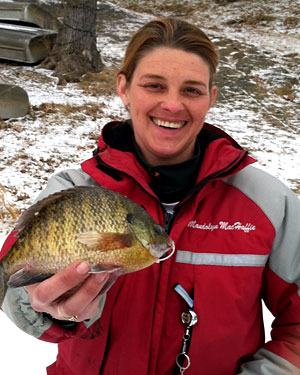

By HARDWATERMANIACS on Jan 29, 2012 with Comments 2
Tungsten jigs are definitely becoming the hot item to have in your ice fishing arsenal these days. Their popularity is only growing. Being three times heavier than lead, tungsten can be molded with a small profile yet maintain a heavy weight when you have to get back down to fish quickly. Tungsten jigs easily drop through slush so you don’t have to be too finicky about cleaning your hole or letting excess light shine through. In my opinion, there is no better ice jig to use with small or finesse plastics.
There are many ways to use tungsten jigs, but, as with every fisherman out there, I have a few tactics of my own that seem to work that I would love to share with you.
First, I always tie my jigs, especially my tungsten jigs, with either a loop knot, or a knot called the ‘figure eight on the bite.’ This is basically a standard loop knot with one twist to the loop before you route your jig through. This knot maximizes the strength of your knot by reducing pinch point tolerances, adding 78% of your line strength throughout the knot.
I use this knot for my tungsten because with the semi- balanced design of most tungsten jigs, especially with a Pelkie design, the jig is free to move and still maintains a natural, horizontal position while fishing it.

The other half of team Hard Water Maniacs, Mandy MacHaffie shows off a big bull bluegill caught through the ice
Although killer with ‘meat’ on the hook, I prefer to use plastics when I fish with tungsten. With the heavy weight of the tungsten jig, it takes minimal movement from the angler to obtain maximum action from your plastic. Small twitches, even as slight as tapping your fingers on your rod blank can make your plastic bait jump and shudder like it just received an electric shock. This is especially important when chasing finicky bull bluegills. At times they don’t want to chase dancing baits.
Making the bait freeze isn’t natural so they will usually leave the scene. With a tungsten jig, you can give the plastic a natural nervous bait movement without really moving the jig which will trigger the old hump heads to bite most of the time.
My first choice in tungsten is tungsten jigs made by Skandia of K&E Stopper lures. High quality tungsten at lower cost than most with all of the hot, fish pounding colors! My favorites are: red with black dot (what I call the “Lady Bug”), yellow with black dot (what I call the “School Bus”), and any in their variety of glow colors.
Try a Skandia tungsten jig and see what all the excitement is about. I guarantee you won’t be disappointed.
Filed Under: Featured • Ice Fishing Tips • Panfish
About the Author:
Thanx for the new tip. I just purchased about 20 tungsten jigs @ the end of last season, but we had ice out and haven’t been able to use them yet. I planned on using waxies with them, what types of plastics do they make for these? They are so small hard to picture in my head.
We use many different plastics with tungsten jigs. K&E offer a few ice plastics that work well. Whip’r Snaps and Whip’r Knockers are a couple. All finesse plastics on the market will work. For smaller tungsten jigs, don’t be afraid to trim the plastic to fit the jig better. Hope this helps.